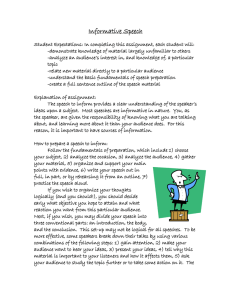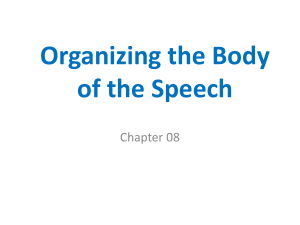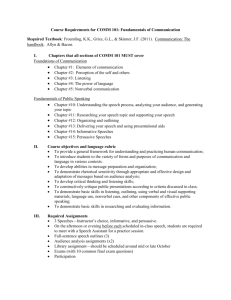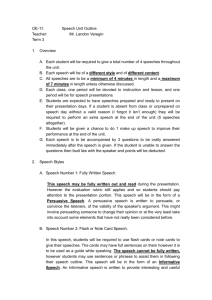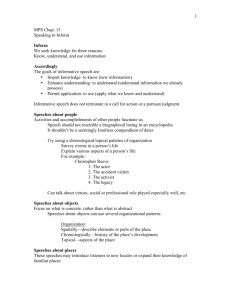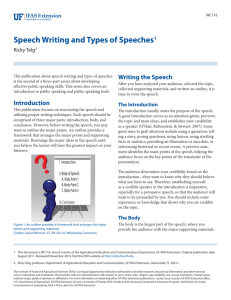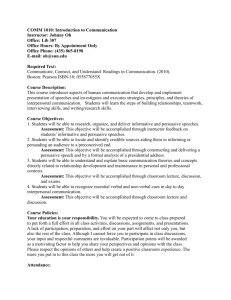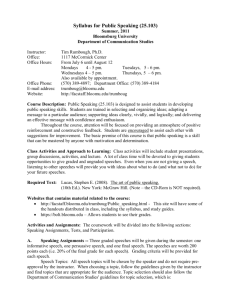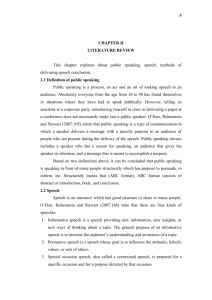Chapter 8 - Ranger College
advertisement
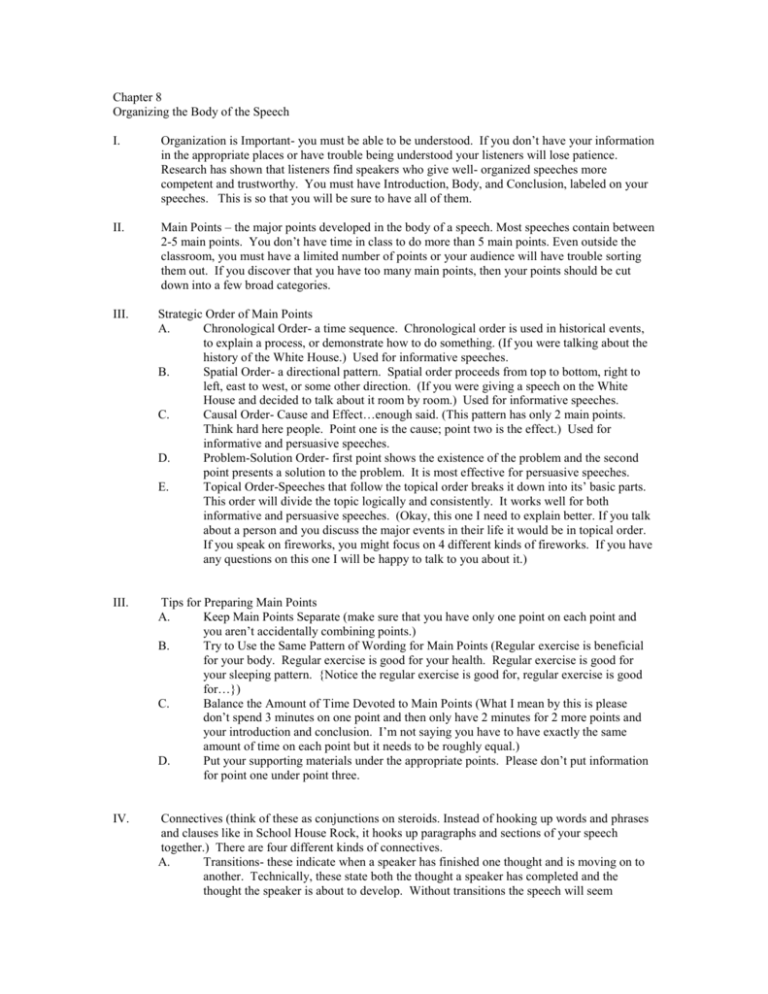
Chapter 8
Organizing the Body of the Speech
I.
Organization is Important- you must be able to be understood. If you don’t have your information
in the appropriate places or have trouble being understood your listeners will lose patience.
Research has shown that listeners find speakers who give well- organized speeches more
competent and trustworthy. You must have Introduction, Body, and Conclusion, labeled on your
speeches. This is so that you will be sure to have all of them.
II.
Main Points – the major points developed in the body of a speech. Most speeches contain between
2-5 main points. You don’t have time in class to do more than 5 main points. Even outside the
classroom, you must have a limited number of points or your audience will have trouble sorting
them out. If you discover that you have too many main points, then your points should be cut
down into a few broad categories.
III.
Strategic Order of Main Points
A.
Chronological Order- a time sequence. Chronological order is used in historical events,
to explain a process, or demonstrate how to do something. (If you were talking about the
history of the White House.) Used for informative speeches.
B.
Spatial Order- a directional pattern. Spatial order proceeds from top to bottom, right to
left, east to west, or some other direction. (If you were giving a speech on the White
House and decided to talk about it room by room.) Used for informative speeches.
C.
Causal Order- Cause and Effect…enough said. (This pattern has only 2 main points.
Think hard here people. Point one is the cause; point two is the effect.) Used for
informative and persuasive speeches.
D.
Problem-Solution Order- first point shows the existence of the problem and the second
point presents a solution to the problem. It is most effective for persuasive speeches.
E.
Topical Order-Speeches that follow the topical order breaks it down into its’ basic parts.
This order will divide the topic logically and consistently. It works well for both
informative and persuasive speeches. (Okay, this one I need to explain better. If you talk
about a person and you discuss the major events in their life it would be in topical order.
If you speak on fireworks, you might focus on 4 different kinds of fireworks. If you have
any questions on this one I will be happy to talk to you about it.)
III.
Tips for Preparing Main Points
A.
Keep Main Points Separate (make sure that you have only one point on each point and
you aren’t accidentally combining points.)
B.
Try to Use the Same Pattern of Wording for Main Points (Regular exercise is beneficial
for your body. Regular exercise is good for your health. Regular exercise is good for
your sleeping pattern. {Notice the regular exercise is good for, regular exercise is good
for…})
C.
Balance the Amount of Time Devoted to Main Points (What I mean by this is please
don’t spend 3 minutes on one point and then only have 2 minutes for 2 more points and
your introduction and conclusion. I’m not saying you have to have exactly the same
amount of time on each point but it needs to be roughly equal.)
D.
Put your supporting materials under the appropriate points. Please don’t put information
for point one under point three.
IV.
Connectives (think of these as conjunctions on steroids. Instead of hooking up words and phrases
and clauses like in School House Rock, it hooks up paragraphs and sections of your speech
together.) There are four different kinds of connectives.
A.
Transitions- these indicate when a speaker has finished one thought and is moving on to
another. Technically, these state both the thought a speaker has completed and the
thought the speaker is about to develop. Without transitions the speech will seem
B.
C.
D.
disjointed and uncoordinated. If you have ever been told that your speech or paper is
choppy or doesn’t flow smoothly then you missed a transition.
Internal Previews- this is where you tell us what you are going to tell us. They let the
audience know what the speaker will talk about next. These are more detailed than
transitions and are rarely necessary for every point. They go great at the end of the
introduction and at the start of a really complex point.
Internal Summaries-This is where you tell us what you told us. These are really good in a
conclusion or at the end of a really complex point.
Signposts- brief statements that indicate exactly where a speaker is in the speech or that
focus attention of key ideas. They can be numerical (First, Second, Third). Questions
also work well as signposts. (How many of you have ever gone to Disney Land?)
Phrases like “Be sure to keep this in mind,” “Above all, you need to know,” “This will
be on the test,” and so on.

